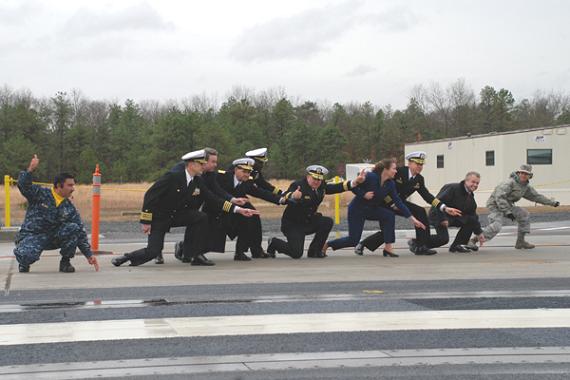Original URL: https://www.theregister.com/2009/11/18/emals_test_facility_opens/
US Navy electromagnetic mass-driver commences tests
Electric machine will toss off Topguns from 2010
Posted in Legal, 18th November 2009 13:14 GMT
A prototype electromagnetic mass-driver, intended to hurl jet aircraft into the sky from the decks of aircraft carriers, has gone into operation at a former airship base in New Jersey. The new kit could be even more important to the Royal Navy than it will be to the US fleet.

Mass-driver kit for shooting robot jets into the stratosphere.
The equipment in question is known as EMALS, the Electro Magnetic Aircraft Launch System, intended to "shoot" jets and turboprops off the deck of the next US nuclear supercarrier - CVN 78, aka USS Gerald R Ford. The EMALS shore test facility held is first ceremonial "shoot" last week at Joint Base McGuire-Dix-Lakehurst, according to the US Naval Air Systems Command.
Current US and French nuclear carriers, the only ones to use catapult launch, employ steam catapults. The steam cat, a British invention, is powered by steam from the ship's propulsion plant and fires aircraft up to flying speed in a very short distance.
Other methods of deck takeoff are possible: Various nations including the UK operate Short Takeoff and Vertical Landing (STOVL) Harrier jets, able to get airborne after a short takeoff run - often with the aid of a "ski-jump" ramp - and return to the deck, lightened by burning fuel and releasing weapons, in a vertical hovering landing. Russian jets take off by ski-jump from Russia's sole, rather rickety carrier under their own power and land using tail hooks and arrester wires like the French and Americans.
The gold-standard method is catapult launch, as it means a jet can get airborne carrying heavier loads. But the current steam cats are hard on aircraft and hell on maintenance - thus the US Navy's aspirations to move to EMALS in its next carrier.
The electromagnetic cat will be able to deliver much more controllable acceleration and won't be so much work to keep in order. Usefully, newer warships nowadays turn their propellers using electric transmissions rather than mechanical gearing, meaning that the ship can easily furnish plenty of electricity.
British carriers need this kit more than American ones do
The new shore rig at Lakehurst will be used from nest month to shoot test loads as the tech is developed. The navy and lead contractor General Atomics expect to start hurling actual aircraft next summer.
Blighty's Royal Navy will be watching the trials with interest. The two new carriers now being built in the UK are planned to be gas-turbine propelled rather than nuclear for reasons of cost, and hence can't use steam catapults. But they have space in their designs where EMALS mass-driver ones could go, if the new kit works.
This would allow Britain to buy much cheaper and more capable aircraft to fly from the ships, as opposed to current plans for expensive stealth jumpjets and TOSS tiltrotor radar craft (or something; the British fleet-radar-bird plans are embryonic at best).
The US Navy officials in charge of the project seem confident, at any rate.
"Steam catapults built at Lakehurst have been used since the 1950s. They've been shot more than five million times," says base bigwig Kathy Donnelly. "Now we move into the era of the electromagnetic catapult, which uses linear motors instead of steam pistons."
The naval part of Joint Base McGuire-Dix-Lakehurst was once known as Lakehurst Naval Air Station, and was a famous airship base in the 1930s - perhaps best known as the site of the Hindenburg disaster. In a context more relevant to the EMALS, however, Lakehurst was also home base to two US Navy aircraft carriers - despite being an airfield rather than a harbour.
The aircraft carriers in question were of course the USS Akron and Macon, enormous dirigibles which carried fighter planes in internal hangar bays. They naturally didn't need catapults or arrester wires, instead using a "trapeze" arm and planes equipped with overhead "skyhooks".
Looking ahead rather than back, there's another crazytech point to note. By the time the electromagnetic catapults are in routine US fleet use, it seems likely that many of the jets they shoot into the sky will be unpiloted robotic ones.
The US Navy EMALS announcement can be read here. ®